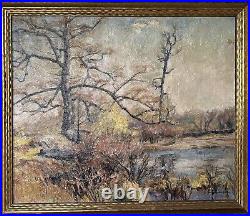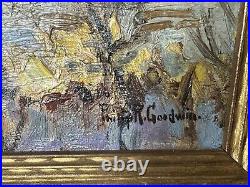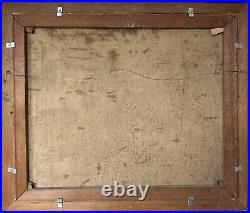Original Philip R Goodwin 1882-1935 Oil Canvas Painting Landscape Scene 25x30




This is not a reproduction! This is landscape painting by this American Painter. The canvas measures 25"x30 and overall with the frame is 28.75" x 33.75.
This painting has been professionally cleaned and ready to be hanged and enjoyed. In light of their son's obvious talent, his parents sent him to the Rhode Island School of Design, and later to the Art Students League in New York City, to further his artistic ability. Impressed by the young artist's abilities Pyle invited Goodwin to join him in Wilmington, Delaware to continue his studies. Perhaps his most significant contribution to Goodwin's work was Pyle's insistence that all good illustration came from first hand knowledge of the subject.
He not only encouraged Goodwin to envision models in costume, but to visit locations before depicting them. In his definitive publication Philip R. Goodwin, America's Sporting & Wildlife Artist, Larry Peterson comments on Goodwin's good fortune of befriending two of the world's most skilled wildlife artists. During a seven-year span, Philip R. Goodwin was given the opportunity to study painting techniques alongside Charles M.
Russell, Carl Rungius, and other respected artists of the time. As a result, Goodwin developed a style that with maturity became uniquely his. From Russell he learned compositional themes of humans surprised by animals that often demonstrated anthropomorphic behavior. Rungius instilled confidence to pursue wildlife painting in a time when few artists attempted this particular genre. In combination, Goodwin's paintings explored matchless natural predicaments.Russell owned a cabin in Montana, which he built in 1906, on property that four years later would become Glacier National Park. The property, affectionately referred to as "Bull Head Lodge, " was situated on Lake McDonald and offered Goodwin a lush backdrop of raw vegetation, sumptuous forests, and imposing mountain peaks. Goodwin, much like the other great outdoorsmen artists of his time, would paint sketches of landscapes, big game animals, and scenes of daily life on the frontier throughout his travels. Carefully recording every detail from the light, to the vivid colors, to the dress of the local cowboys and Native Americans, he used these vignettes to create large scale works back at his studio in New York.
Goodwin managed to earn a living illustrating, publishing works in "Everybody's, " "Harper's Monthly, " "Harper's Weekly, " "Outing, " "Persimmon Hill Magazine, " and Scribner's. Goodwin's illustrations were also used by Brown and Bigelow for their calendars, as well as in advertisements for several major firearms dealers. These commissions brought about more opportunities for Goodwin, among them, illustrating books by some of the most celebrated authors of the day, including Jack London's "Call of the Wild" and Theodore Roosevelt's African Game Trails.
This latter commission was especially notable for the artist, who was hand-picked by Roosevelt to illustrate his book. Goodwin continued to scrape by illustrating, and eventually built up a clientele for his oil paintings as well. The Great Depression, however, hit him hard and he spent the last several years of his life in somewhat perilous financial straits. He passed away of pneumonia on December 14, 1935, but his art continued to be published through "Sports Afield, " Brown & Bigelow, and by companies such as Kemper Thomas Company and Standard Oil.
